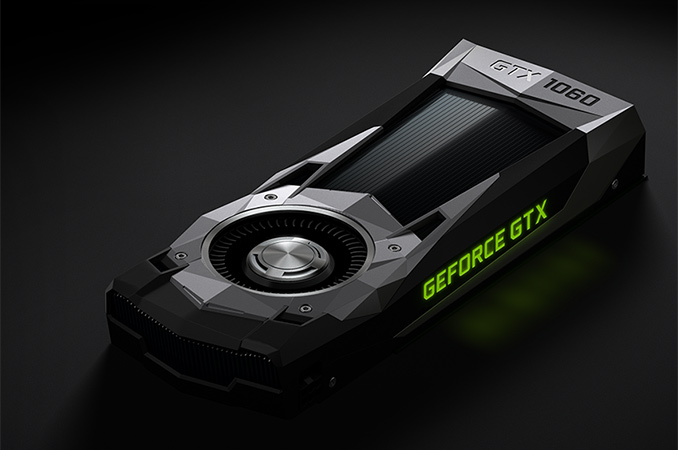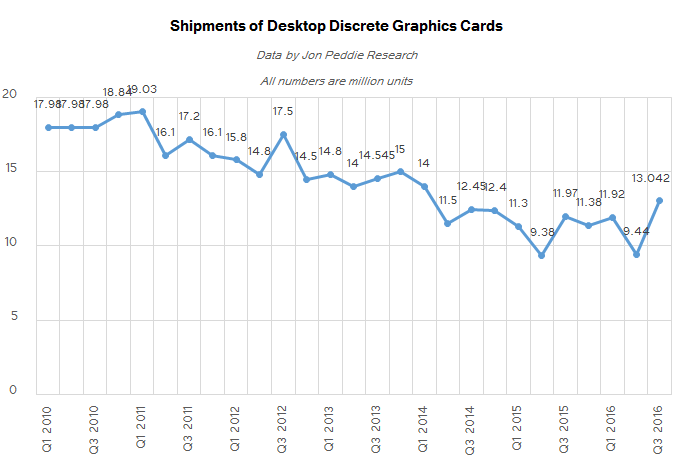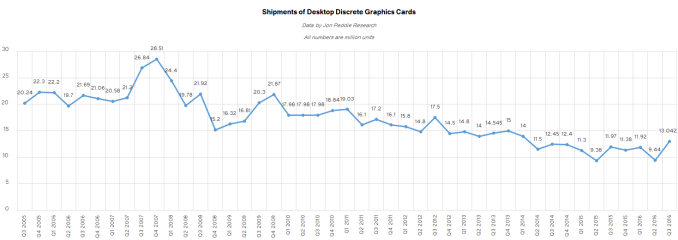Discrete Desktop GPU Market Trends Q3 2016: GPU Shipments Hit Two-Year High
by Anton Shilov on November 28, 2016 9:00 AM EST
Shipments of discrete graphics processing units (GPUs) are traditionally high in the third quarter as PC makers and retailers gear up for the holiday season and build up stocks of components. Q3 2016 was particularly good for standalone GPUs because both AMD and NVIDIA introduced a number of new products for different market segments from May to August. Sales of discrete graphics cards for desktop PCs hit a two-year high in the third quarter, according to data released by Jon Peddie Research. What is important is that standalone GPUs performed very well despite a shrink of PC sales.
Q3 2016: Good for GPUs, Mediocre for PCs
In the third quarter of 2016, the industry sold from 68 million (a 3.9% year-over-year decline, according to IDC) to 68.9 million of PCs (a 5.7% YoY decline according to Gartner). The numbers are up from the second quarter of 2016, but are down from the same period a year ago. A good news is that sales of gaming desktop and notebook PCs are strong, which is why shipments of standalone graphics processors were strong as well. JPR believes that around 34.84% of PCs shipped in Q3 used discrete GPUs. Based on the numbers from IDC and Gartner, we can estimate that this should be between 23.7 and 24.0 million standalone graphics chips were shipped by AMD and NVIDIA in Q3 (assuming that PCs with discrete GPUs had only one discrete card, which is not far from truth as sales of multi-GPU systems are not high in terms of volumes). Nevertheless, keep in mind that data from JPR, IDC and Gartner reflects sold-in numbers - units from distributors rather than end-user sales - which means that not all GPUs ended up in systems already purchased by the end-user.
Fueled by the release of AMD’s Radeon RX family of discrete GPUs for desktops as well as NVIDIA’s launch of its GeForce GTX 10-series line, shipments of graphics cards for desktops increased 38.16% quarter-over-quarter (QoQ) in Q3, according to Jon Peddie Research. JPR does not officially disclose how many graphics adapters for desktop PCs were sold in the third quarter, but based on the company’s previously released numbers, we can estimate that various makers of add-in boards (AIBs) sold approximately 13.04 million video cards, which is up from 11.97 million units in Q3 2015 (see notes below). It is hard to estimate how many standalone GPUs for notebooks were shipped, during the discussed period, but we may be talking about roughly 10 million units.
| Desktop Discrete Graphics Cards Market in Q3 2016 Data calculated from Jon Peddie Research News Numbers are in percentage points or in millions. Numbers are approximate. |
||||||||
| Q3 2016 (current) |
Q2 2016 (previous Q) |
Q3 2015 (previous Y) |
||||||
| Share | Shipments | Share | Shipments | Share | Shipments | |||
| AMD | 29.1% | ~3.80 | 29.9% | ~2.82 | 18.8% | ~2.25 | ||
| NVIDIA | 70.9% | ~9.25 | 70% | ~6.60 | 81.1% | ~9.71 | ||
| Other | 0% | 0 | 0.1% | ~0.0094 | 0% | 0 | ||
| Total | 100% | ~13.04 | 100% | ~9.44 | 100% | ~11.97 | ||
It is evident that Q3 was a good year for desktop graphics cards in general. Moreover, the whole year to date has been positive for AIBs. Various manufacturers have sold a total 34.40 million GPUs in the first three quarters, up 5.35% from a total of 32.65 million in Q1+Q2+Q3 of 2015. Analysts from Jon Peddie Research attribute increases of desktop GPU shipments to new gaming content as well as the promise of virtual reality. Since more new games are about to be released in Q4 and because VR remains a highly discussed topic in the gaming community, it is likely that shipments of desktop discrete GPUs are going to stay at high levels for a while. Nonetheless, it remains to be seen whether their sales in Q4 beat their sales in Q3 (which sometimes happens, especially in cases when supply does not meet demand in Q3).
One of the things to note is the consolidation of the PC market. The three largest PC vendors (Lenovo, HP, Dell) controlled over 58% of the worldwide market in Q3 2016, up from 55% a year ago and 51% in 2014. Such consolidation happens not only because they can negotiate better deals with their suppliers and thus offer better pricing, but also because they are gradually expanding their product families. On the one hand they add mini PCs to their lineups, and on the other they roll-out gaming PCs. For example, this year we observed HP’s return to the market of gaming desktops with the Omen X and ASUS’ release of the ROG GT51 for $4999. Moreover, as markets such as VR are gaining publicity, large PC vendors will try to capitalize on this and offer gaming systems with discrete GPUs. Unfortunately, we have no idea whether this is going to be a long-lasting trend.












53 Comments
View All Comments
Atique786 - Friday, October 1, 2021 - link
This is a very informative and interesting article. I have enjoyed reading your post and have come to the conclusion that you are a professional writer.https://realrelaxmassagechairreview.com/
<a href="https://realrelaxmassagechairreview.com/">... Relax Massage Chairs</a>
<a href="https://realrelaxmassagechairreview.com/real-relax... Relax Massage Chair Review</a>
<a href="https://realrelaxmassagechairreview.com/real-relax... Relax 2020 Massage Chair</a>
Atique786 - Friday, October 1, 2021 - link
This is a very informative and interesting article. I have enjoyed reading your post and have come to the conclusion that you are a professional writer.https://realrelaxmassagechairreview.com/
<a href="https://realrelaxmassagechairreview.com/">... Relax Massage Chairs</a>
<a href="https://realrelaxmassagechairreview.com/real-relax... Relax Massage Chair Review</a>
<a href="https://realrelaxmassagechairreview.com/real-relax... Relax 2020 Massage Chair</a>
tipoo - Monday, November 28, 2016 - link
This is an important counterpoint to the "PC shipments are falling" doom and gloom. PC shipments are falling because a 5 year old 2500K can still run modern games if the GPU allows. But PC /gaming components/ are on the upswing, so it's still a great time to be a PC gamer. Complete system sales are tertiary.BrokenCrayons - Monday, November 28, 2016 - link
This sums up the state of the declining computer sales nicely. While CPU performance and platform features (minor nod to USB) haven't pushed the performance envelope enough to matter AND software isn't demanding more, the GPU industry is driven by pent-up demand for a die shrink and widespread increases in screen resolution.Threska - Sunday, December 4, 2016 - link
Well the killer uses for GPUs are going to be VR and machine learning.0ldman79 - Monday, November 28, 2016 - link
That's not necessarily a problem.We need tech to settle a bit. That might actually increase overall ownership and total market penetration. Having to upgrade the machine every two years just to keep up has kept a lot of people out of the market for anything but the cheapo computer.
Strunf - Thursday, December 8, 2016 - link
People didn't upgrade the machines every two years to keep up, CPU wise we have reached a good enough CPU for the average user like 10 years ago, people who upgrade every 2 years are enthusiasts and they will keep to do so, the ones who stopped upgrading are the ones that have a already good enough PC... or the vast majority of PC users and companies.There isn't really a problem, PC shipment will keep going down cause a PC has nowadays a very long useful life and cause of other technologies, tablets already replaced the PC on many households... my guess in a few years Gamers will represent the vast majority of the PC users and until then desktop PC sales will keep going down, and even then there are new technologies that allow to play PC Games over the network without even having a PC.
stephenbrooks - Tuesday, November 29, 2016 - link
Another thing to bear in mind with these graphs is the comparative improvement of integrated graphics over the time frame. It must be eating the low-end of discrete GPUs by this point.Samus - Tuesday, November 29, 2016 - link
The problem isn't just a 5 year old 2500K is adequate for most common games, but many other tasks, especially simple content consumption, are clearly delegated to other devices most prominently smart phones and tablets.Unless you desire a PC for gaming, or you are a business owner that is sticking to the legacy operations schema (and not modernizing your IT infrastructure) then desktop PC's don't offer any clear compelling advantage over laptops and mobile devices.
Meteor2 - Wednesday, November 30, 2016 - link
Well, AIOs look nice, and are nice to use. Whether they're actually 'desktops', as they use laptop components, is another question.